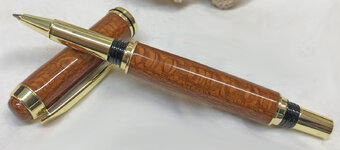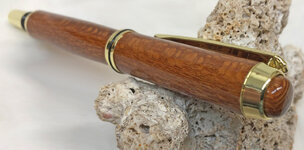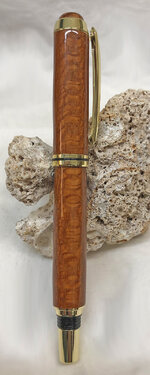egnald
Member
Greetings on this 2022 New Year's Day from the bitter cold Nebraska.
Last month I worked on learning how to make custom finials for the Jr. Gent kits. (With a big thanks to Mark James, John Underhill, Ken Burgess, Peter Christensen, and everyone else that helped me figure out the best way to do this with the tools and equipment I have available).
This is a Jr. Gent with a custom finial made from an offcut piece of Brazilian Lacewood that I picked up in Lincoln, Nebraska at Hardwood Heaven about 4 years ago. I've made a pen from Lacewood before, but I forgot how nice its grain structure is.
Anyhow, here are the thumbnail pictures - Dave
A couple of glamor shots:


Pictures of the open pen as it is rotated to show the variation in the grain:



Pictures of the closed pen as it is rotated to show the grain and grain matching):



Last month I worked on learning how to make custom finials for the Jr. Gent kits. (With a big thanks to Mark James, John Underhill, Ken Burgess, Peter Christensen, and everyone else that helped me figure out the best way to do this with the tools and equipment I have available).
This is a Jr. Gent with a custom finial made from an offcut piece of Brazilian Lacewood that I picked up in Lincoln, Nebraska at Hardwood Heaven about 4 years ago. I've made a pen from Lacewood before, but I forgot how nice its grain structure is.
Anyhow, here are the thumbnail pictures - Dave
A couple of glamor shots:


Pictures of the open pen as it is rotated to show the variation in the grain:



Pictures of the closed pen as it is rotated to show the grain and grain matching):




